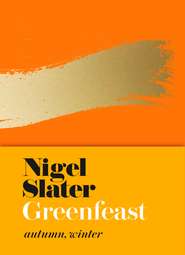По всем вопросам обращайтесь на: info@litportal.ru
(©) 2003-2024.
✖
The Kitchen Diaries II
Настройки чтения
Размер шрифта
Высота строк
Поля
Halve the pears, remove the cores and slice the pears thinly, then add them to the herb and yoghurt dressing.
Put the salad leaves in a serving dish. Pile the pears and their dressing on top. Using a vegetable peeler, shave off small, thin slices of the cheese and scatter them over the salad with the assorted sprouted seeds.
Enough for 2
JANUARY 5
Twelfth Night
The day that precedes Twelfth Night is often the darkest in my calendar. The sadness of taking down The Tree, packing up the mercury glass decorations in tissue and cardboard and rolling up the strings of tiny lights has long made my heart sink. Today I descend further than usual.
The rain is torrential and continuous. I clean the bedroom cupboards, make neat piles of books and untidy ones of clothes ready for the charity shop and make a list of major and minor jobs to do in the house over the next few months.
The local council collects discarded Christmas trees and recycles them for compost. I keep mine at home, cutting every branch from the main stem with secateurs and packing them into sacks. Over the next few weeks, the needles will fall and end their days around the blueberries and cloudberries in the garden. There is much that appeals about this annual cycle of the tree going back into the earth.
You would think that this day of darkness would be predictable enough for me to organise something to lift the spirits – dinner with friends or a day away from home. But the consequences of evergreens left in the house after Twelfth Night is too great a risk, even though this superstition is quite recent. So a day of dark spirits it is.
JANUARY 6
Epiphany
After yesterday’s darkness and self-indulgence, I open the kitchen door to find the garden refreshed after the rain. The air is suddenly sweet and clean, you can smell the soil, and the ivy and yew are shining bright. The dead leaves are blown away, the sky clear and white. There is a new energy and I want to cook again.
Today is an important day for those who grow their vegetables bio-dynamically, when the Three Kings preparation – a stir-up containing gold, frankincense and myrrh – is ground for an hour, then made into a paste with rain or pond water and offered to the land. Jane Scotter at Fern Verrow, the Herefordshire farmer from whom I buy the vegetables I cannot grow for myself (for which read most), says it smells ‘like a fine fruity Christmas cake’. ‘We do this to invite elemental life forces to help and guide us for the coming growing season. We ask for good things to happen and give the preparation as an offering to the earth and to give thanks for what the universe provides. It is a lovely thing to do and a chance to walk around the farm on a route not usually taken, holding thoughts of thanks and wishes to the farm on a spiritual level.’
Hippy-dippy hocus-pocus it may sound, but I have far less of a problem believing in this than I do many of the religious ceremonies practised by millions. Actually, much less so.
My energy and curiosity may be renewed but the larder isn’t. There is probably less food in the house than there has ever been. I trudge out to buy a few chicken pieces and a bag of winter greens to make a soup with the spices and noodles I have in the cupboard. What ends up as dinner is clear, bright and life-enhancing. It has vitality (that’s the greens), warmth (ginger, cinnamon) and it is economical and sustaining too. I suddenly feel ready for anything the New Year might throw at me.
Chicken noodle broth
chicken pieces and wings: 400g
black peppercorns: 8
star anise: 2
half a cinnamon stick
palm sugar: a scant teaspoon
fresh ginger: a small lump
fine, rice noodles: 200g
greens: about 400g
Thai or Vietnamese basil: a small handful
Make the chicken broth: put the chicken pieces and wings in a deep pan with the whole peppercorns, star anise, cinnamon stick and palm sugar. Peel the ginger, cut it into coins and add to the pan. Pour in a litre of water and bring to the boil. Turn down the heat and leave to simmer, at a gentle bubble, for twenty-five minutes. Remove from the heat and set aside.
Cook the noodles according to the instructions on the packet, then drain and set aside. Trim, wash and lightly steam the greens, then refresh under cold running water.
Divide the hot broth between four bowls, add the noodles and greens and finish with the basil.
Enough for 4
JANUARY 9
An old-fashioned ham, a new sauce
We have never been what you might call a ‘close’ family. A mother and father dead by the time I reached my late teens; a brother who emigrated; an uncle distanced by his obsession with religion. The family member I was closest to was a mischievous, twinkly-eyed aunt whose diet consisted solely of Cup-a-Soup, Bailey’s Irish Cream and a regular swig of Benylin. She lived to be a hundred, which puts the healthy-eating lobby firmly in its place.
When I was a child, she would take me to see my grandmother, a tiny, bent woman (I have inherited her shoulders), whose curtains were permanently drawn. My grandmother’s kitchen always had a pot on the stove and condensation running down the windows. The room was dark and smelled of boiling gammon and the smoke from the coal fire in the parlour. Yet despite the suggestion of food on its way, the scene was less than welcoming. No jolly granny with a laden tea table here, just a tired old lady, exhausted from a hard life spent bringing up five children on her own.
The smell of a ham puttering away in my own kitchen still reminds me of her – I suspect it always will – but now comes with a welcome. Thinly cut ham, warm from its cooking liquor, is a dish I too bring out to feed the hordes. Reasonably priced, presented on a large, oval plate with a jug of bright-green sauce, it seems to go a long way. A piece weighing just over a kilo will feed six, with leftovers for a winter salad the following day.
Parsley sauce is the old-school accompaniment to a dish of warm ham, but far from the only one. This week I put a bag of knobbly Jerusalem artichokes to good use, serving them roasted as a side dish to the ham and to add interest to the accompanying parsley sauce. Artichokes and parsley have an affinity with pork and with each other – I like to add bacon and the chopped herb to the roasted tubers, and snippets of crisp smoked streaky often find their way on to the surface of a bowl of parsley-freckled artichoke soup.
Any large lump of ham will do for slow cooking in water (I sometimes use apple juice). A ‘hand’ of pork, which comes from the top of the front legs and is what the French call jambonneau, is a sound cut for those who want to cook theirs on the bone. A piece of rolled and tied leg is easier to carve for a large number. A cut cooked on the bone shouldn’t give any trouble after an hour and a half on the stove. The meat should fall away with just a tug from a fork.
This is an unapologetically old-fashioned dish and the best accompaniments are those of a gentle nature: a quiet, cosseting sauce, some floury steamed potatoes and possibly the inclusion of some mild mustard, either in the sauce or on the edge of the plate. The recipe can be energised a bit in summer, when it will benefit from a bright-green, olive-oil-and herb-based sauce. But on a day as bone chilling as this, it needs an accompaniment as comforting as a goose-down duvet. We passed round a plate of apples and a lump of milky Cotherstone afterwards.
Ham with artichoke and parsley sauce
Some cooks like to soak their ham before cooking – a precaution against a salty ham. Overly salted hams seem to be a thing of the past, so I don’t bother. It is worth doing if you are unsure of your ham. I’m not convinced the sauce needs any cream but, should you wish to soften it further, 3 tablespoons of double cream will be enough. Serve with the roast artichokes below and large chunks of steamed potato.
a piece of boiling ham weighing about 1.5kg
onions: 2
bay leaves: 2
thyme: 4 short sprigs
black peppercorns: 15 or so
parsley stalks: 6–8
For the sauce:
Jerusalem artichokes: 250g
butter: a thin slice, about 20g
the onions from the ham liquor
parsley: a small bunch, about 15g











